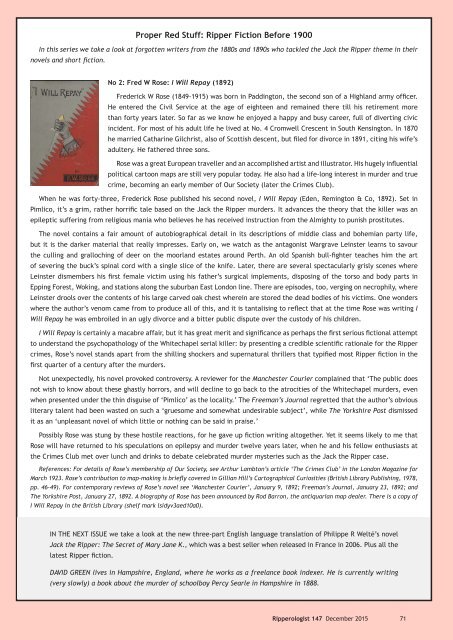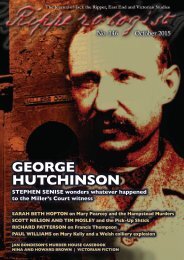Edmund Reid
nuhf574
nuhf574
You also want an ePaper? Increase the reach of your titles
YUMPU automatically turns print PDFs into web optimized ePapers that Google loves.
Proper Red Stuff: Ripper Fiction Before 1900<br />
In this series we take a look at forgotten writers from the 1880s and 1890s who tackled the Jack the Ripper theme in their<br />
novels and short fiction.<br />
No 2: Fred W Rose: I Will Repay (1892)<br />
Frederick W Rose (1849-1915) was born in Paddington, the second son of a Highland army officer.<br />
He entered the Civil Service at the age of eighteen and remained there till his retirement more<br />
than forty years later. So far as we know he enjoyed a happy and busy career, full of diverting civic<br />
incident. For most of his adult life he lived at No. 4 Cromwell Crescent in South Kensington. In 1870<br />
he married Catharine Gilchrist, also of Scottish descent, but filed for divorce in 1891, citing his wife’s<br />
adultery. He fathered three sons.<br />
Rose was a great European traveller and an accomplished artist and illustrator. His hugely influential<br />
political cartoon maps are still very popular today. He also had a life-long interest in murder and true<br />
crime, becoming an early member of Our Society (later the Crimes Club).<br />
When he was forty-three, Frederick Rose published his second novel, I Will Repay (Eden, Remington & Co, 1892). Set in<br />
Pimlico, it’s a grim, rather horrific tale based on the Jack the Ripper murders. It advances the theory that the killer was an<br />
epileptic suffering from religious mania who believes he has received instruction from the Almighty to punish prostitutes.<br />
The novel contains a fair amount of autobiographical detail in its descriptions of middle class and bohemian party life,<br />
but it is the darker material that really impresses. Early on, we watch as the antagonist Wargrave Leinster learns to savour<br />
the culling and gralloching of deer on the moorland estates around Perth. An old Spanish bull-fighter teaches him the art<br />
of severing the buck’s spinal cord with a single slice of the knife. Later, there are several spectacularly grisly scenes where<br />
Leinster dismembers his first female victim using his father’s surgical implements, disposing of the torso and body parts in<br />
Epping Forest, Woking, and stations along the suburban East London line. There are episodes, too, verging on necrophily, where<br />
Leinster drools over the contents of his large carved oak chest wherein are stored the dead bodies of his victims. One wonders<br />
where the author’s venom came from to produce all of this, and it is tantalising to reflect that at the time Rose was writing I<br />
Will Repay he was embroiled in an ugly divorce and a bitter public dispute over the custody of his children.<br />
I Will Repay is certainly a macabre affair, but it has great merit and significance as perhaps the first serious fictional attempt<br />
to understand the psychopathology of the Whitechapel serial killer: by presenting a credible scientific rationale for the Ripper<br />
crimes, Rose’s novel stands apart from the shilling shockers and supernatural thrillers that typified most Ripper fiction in the<br />
first quarter of a century after the murders.<br />
Not unexpectedly, his novel provoked controversy. A reviewer for the Manchester Courier complained that ‘The public does<br />
not wish to know about these ghastly horrors, and will decline to go back to the atrocities of the Whitechapel murders, even<br />
when presented under the thin disguise of ‘Pimlico’ as the locality.’ The Freeman’s Journal regretted that the author’s obvious<br />
literary talent had been wasted on such a ‘gruesome and somewhat undesirable subject’, while The Yorkshire Post dismissed<br />
it as an ‘unpleasant novel of which little or nothing can be said in praise.’<br />
Possibly Rose was stung by these hostile reactions, for he gave up fiction writing altogether. Yet it seems likely to me that<br />
Rose will have returned to his speculations on epilepsy and murder twelve years later, when he and his fellow enthusiasts at<br />
the Crimes Club met over lunch and drinks to debate celebrated murder mysteries such as the Jack the Ripper case.<br />
References: For details of Rose’s membership of Our Society, see Arthur Lambton’s article ‘The Crimes Club’ in the London Magazine for<br />
March 1923. Rose’s contribution to map-making is briefly covered in Gillian Hill’s Cartographical Curiosities (British Library Publishing, 1978,<br />
pp. 46-49). For contemporary reviews of Rose’s novel see ‘Manchester Courier’, January 9, 1892; Freeman’s Journal, January 23, 1892; and<br />
The Yorkshire Post, January 27, 1892. A biography of Rose has been announced by Rod Barron, the antiquarian map dealer. There is a copy of<br />
I Will Repay in the British Library (shelf mark lsidyv3aed10a0).<br />
IN THE NEXT ISSUE we take a look at the new three-part English language translation of Philippe R Welté’s novel<br />
Jack the Ripper: The Secret of Mary Jane K., which was a best seller when released in France in 2006. Plus all the<br />
latest Ripper fiction.<br />
DAVID GREEN lives in Hampshire, England, where he works as a freelance book indexer. He is currently writing<br />
(very slowly) a book about the murder of schoolboy Percy Searle in Hampshire in 1888.<br />
Ripperologist 147 December 2015 71




